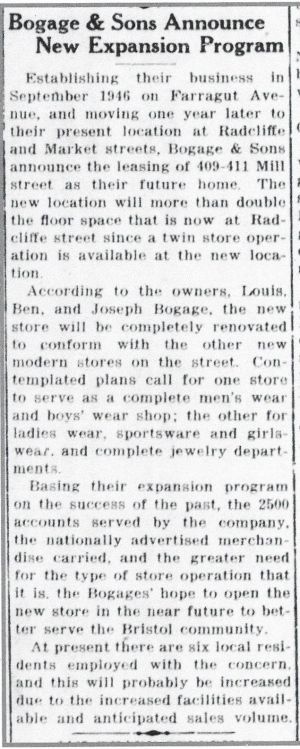Talk:Bogage and Sons: Difference between revisions
Estellesass (talk | contribs) No edit summary |
Estellesass (talk | contribs) No edit summary |
||
| Line 1: | Line 1: | ||
Consumer credit 50 or 100 years ago existed on a wide scale but looked a lot different than it does today. Today, credit cards and digital credit instruments (e.g. Apple Pay) are both corporate and anonymous. Consumers don't face their creditors unless they fall behind on their payments. Even then, the collector they face is generally a corporate third party, still anonymous and impersonal. The business of credit in the first half of the 20th century, however, was very personal. When a business offered its customers credit, it often meant that the business hired employees whose job it was to collect weekly payments, going door to door, from those who had "accounts" with the business. | [[File:B&Sons1.jpg|300px|thumb|right|The Bristol Daily Courier, Nov. 25, 1949]]Consumer credit 50 or 100 years ago existed on a wide scale but looked a lot different than it does today. Today, credit cards and digital credit instruments (e.g. Apple Pay) are both corporate and anonymous. Consumers don't face their creditors unless they fall behind on their payments. Even then, the collector they face is generally a corporate third party, still anonymous and impersonal. The business of credit in the first half of the 20th century, however, was very personal. When a business offered its customers credit, it often meant that the business hired employees whose job it was to collect weekly payments, going door to door, from those who had "accounts" with the business. | ||
Louis Bogage was a salesman. He was selling pickles in Harlem when he married Annie Dobrin in 1915, and he was peddling curtains door to door in Worcester when he met Rebecca Fishman in 1919. He continued selling, most often door to door, and collecting payments on account in Trenton, with his occupation variously listed as collector (one time, in the business of poultry) and/or salesman. He spent a few years working at Kaplan's in Trenton (a retail business) before taking that business model and starting Bogage and Sons in Bristol. Not surprisingly, the business of Bogage and Sons relied heavily on their customers' credit. They offered "Nationally Advertised Brands," such as Jonathan Logan and Hart Shaffner and Marx, and encouraged buyers to use their credit. In fact, the company cited their 2,500 credit accounts in 1949 as evidence of their success and one reason for the expansion and relocation of the store. | Louis Bogage was a salesman. He was selling pickles in Harlem when he married Annie Dobrin in 1915, and he was peddling curtains door to door in Worcester when he met Rebecca Fishman in 1919. He continued selling, most often door to door, and collecting payments on account in Trenton, with his occupation variously listed as collector (one time, in the business of poultry) and/or salesman. He spent a few years working at Kaplan's in Trenton (a retail business) before taking that business model and starting Bogage and Sons in Bristol. Not surprisingly, the business of Bogage and Sons relied heavily on their customers' credit. They offered "Nationally Advertised Brands," such as Jonathan Logan and Hart Shaffner and Marx, and encouraged buyers to use their credit. In fact, the company cited their 2,500 credit accounts in 1949 as evidence of their success and one reason for the expansion and relocation of the store. | ||
[[User:Estellesass|Estellesass]] ([[User talk:Estellesass|talk]]) 11:20, 8 August 2020 (MDT) Estellesass [[User:Estellesass|Estellesass]] ([[User talk:Estellesass|talk]]) 11:20, 8 August 2020 (MDT) | [[User:Estellesass|Estellesass]] ([[User talk:Estellesass|talk]]) 11:20, 8 August 2020 (MDT) Estellesass [[User:Estellesass|Estellesass]] ([[User talk:Estellesass|talk]]) 11:20, 8 August 2020 (MDT) | ||
Revision as of 11:23, 8 August 2020
Consumer credit 50 or 100 years ago existed on a wide scale but looked a lot different than it does today. Today, credit cards and digital credit instruments (e.g. Apple Pay) are both corporate and anonymous. Consumers don't face their creditors unless they fall behind on their payments. Even then, the collector they face is generally a corporate third party, still anonymous and impersonal. The business of credit in the first half of the 20th century, however, was very personal. When a business offered its customers credit, it often meant that the business hired employees whose job it was to collect weekly payments, going door to door, from those who had "accounts" with the business.
Louis Bogage was a salesman. He was selling pickles in Harlem when he married Annie Dobrin in 1915, and he was peddling curtains door to door in Worcester when he met Rebecca Fishman in 1919. He continued selling, most often door to door, and collecting payments on account in Trenton, with his occupation variously listed as collector (one time, in the business of poultry) and/or salesman. He spent a few years working at Kaplan's in Trenton (a retail business) before taking that business model and starting Bogage and Sons in Bristol. Not surprisingly, the business of Bogage and Sons relied heavily on their customers' credit. They offered "Nationally Advertised Brands," such as Jonathan Logan and Hart Shaffner and Marx, and encouraged buyers to use their credit. In fact, the company cited their 2,500 credit accounts in 1949 as evidence of their success and one reason for the expansion and relocation of the store.
Estellesass (talk) 11:20, 8 August 2020 (MDT) Estellesass Estellesass (talk) 11:20, 8 August 2020 (MDT)
